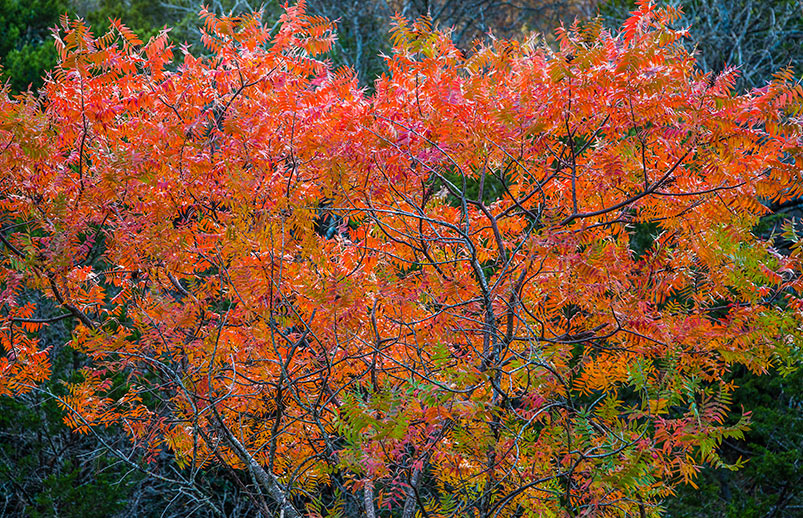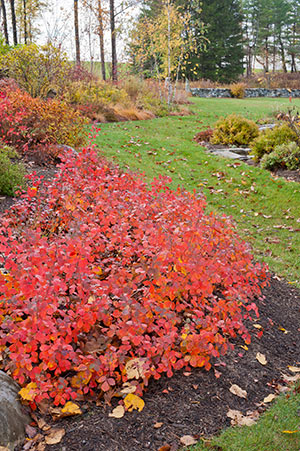Just the Thicket

Prairie flameleaf sumac (Rhus lanceolata), true to its name, burns up the landscape with vibrant orange and fierce scarlet. Shrubs that spread by suckering, like this one, provide a host of benefits, such as filling in large areas with little gardening elbow grease on your part. PHOTO Steven Schwartzman
SOMETIMES ROWDY CHARACTERS too boisterous for polite company turn out to be real champs in a different setting. Like many gardeners, I’ve learned the hard way why some aggressively colonizing plants have a bad reputation. Suckering thicket-forming shrubs and small trees — such as wild roses, coralberry (Symphoricarpos orbiculatus) and sumacs (Rhus spp.) — can be way too much of a good thing in a well-tended garden. But their “can’t keep ’em down” pioneering spirit is a real boon if you want super-low maintenance plants that hold ground and provide great shelter for wildlife.
My affection for these types of plants stems from close encounters with a grove of staghorn sumacs (Rhus typhina) near my childhood home. I loved slipping under the billowing green canopy to daydream inside, unseen. I’m still struck by sumac’s particular beauty, but as a hardworking homeowner I also appreciate the self-sustaining nature of most suckering shrub thickets. They’re self-mulching and self-fertilizing as leaf litter decomposes. And they provide great cover for more than just reclusive, nature-loving kids: They’re too dense for weeds — but not too dense for nesting birds, small mammals and overwintering insects.
Botanically speaking, suckers shoot up along the length of horizontal underground stems called rhizomes (blackberries and raspberries, for instance, sucker). Runners or stolons, on the other hand, are above-ground stems that develop roots and shoots where they touch the ground. In each case, the parent plant, grown from a seed perhaps dropped by a bird, spreads out to form a colony over time. Each member of the colony is a genetically identical clone. Shrubs that expand by any of these vegetative methods (some spread by more than one) have incited many a gardener to complain: “These darned things sucker all over the place.” Lumping these clonal shrubs together as “suckering” may be technically imprecise, but it leads us toward understanding how to harness and appreciate their expansive nature and unique beauty.

LEFT Like a bundle of white pipe-cleaners, Virginia sweetspire (Itea virginica) looks festive in bloom, and foliage turns red or purple in the winter, adding jewel tones to otherwise drab landscapes. CENTER Stoloniferous red osier dogwood (Cornus sericea) brings color to shorelines in the form of ruddy stems and creamy white blossoms. RIGHT Lime green buds burst into fuzzy white pompons on dwarf witchalder (Fothergilla gardenii), shown here at the Tower Hill Botanical Garden in Boylston, Massachusetts. PHOTOS Karen Bussolini
If your yard has places too steep, rocky or wet to easily plant, tend or mow, or you’re looking for an informal privacy screen, more wildlife habitat and less lawn, these self-reliant occupiers have much to offer. As Wildflower Center Director of Horticulture Andrea DeLong-Amaya says of prairie flameleaf sumac (Rhus lanceolata), “It’s one of our best plants for fall color and pretty drought tolerant too, but its thicket-forming habit makes it really annoying in a small garden. In the right place, it’s great for bank stabilization or where you have a lot of space to fill. You can get more plants from one if you have the patience, just let them fill in.”
Walking through a meadow with mature suckering shrub thickets is like navigating a landscape of cloudlike islands. Each thicket is a clonal colony with a characteristic pattern of numerous individual, genetically identical stems. This internal architecture is concealed by foliage until winter reveals all. The tallest oldest stems are surrounded by somewhat shorter stems, which in turn are skirted by younger, shorter shoots, the colony’s height progressively diminishing as it expands outward. The loose form of this growth pattern is especially suited to informal situations and large spaces. Given strict boundaries (constructed or mowed), the tendency to fill in all available space can be employed in formal settings as well.
Ecological landscape designer Larry Weaner, author, with Thomas Christopher, of recently published “Garden Revolution: How Our Landscapes Can Be a Source of Environmental Change,” describes the difference between clump-forming and suckering shrubs in ecological terms. With clump-forming shrubs, “Their compact, nonspreading pattern of growth makes [them] more suitable for intermingling with other shrubs or with perennials and grasses.” They’re leggy, so while they may have berries for wildlife, an individual shrub doesn’t provide much cover. “From an ecological standpoint,” he says, “[Clump-forming shrubs] are most functional when planted in mass, so they provide both berries and cover.”
… clonal shrubs are some of the most weed-suppressive, soil-stabilizing and wildlife-friendly plants you can put in your garden.
Suckering shrub thickets operate differently, he explains. Except for staghorn sumac, with elongated stems that admit light to plants below, mature stands of suckering shrubs exclude almost all undergrowth. “Precisely because of their thicket-forming characteristic, clonal shrubs are some of the most weed-suppressive, soil-stabilizing and wildlife-friendly plants you can put in your garden.” He goes on, however, to note that cultivars are an exception.
Weaner and Don Segal of The Plantsmen Nursery near Ithaca, New York, have long compared observations of wild and cultivated native plants. They’ve noticed that inkberry (Ilex glabra) and winterberry hollies (Ilex verticillata) form extensive colonies in the wild, and summer sweet (Clethra alnifolia) thickets can run for miles around lakes, but cultivars of these plants seem different. Propagated by cuttings, as almost all are in the trade, they seem to develop a clumping habit or reluctance to spread, perhaps making them better garden companions and less useful as colonizers.
“Unimproved” seed-grown species like gray dogwood (Cornus racemosa), sweet-fern (Comptonia peregrina) or fragrant sumac (Rhus aromatica) are hard to improve upon if you want to cover ground without breaking the bank. Weaner notes that small plants usually get established faster than big ones and anything growing between them will be temporary. He often plants a few inexpensive plugs of inland sea oats (Chasmanthium latifolium) under bottlebrush buckeyes (Aesculus parviflora). The grass self-sows prolifically and occupies ground until the bottlebrush buckeye eventually forms an impenetrable thicket. “That way you can fill in without spending a lot of money and wasting it, because [the sea oats] won’t last.”
Setting a line is the secret to controlling these rambunctious plants, whether pavement, confining structures, mowing or occasional grubbing out. DeLong-Amaya tends drought-tolerant coralberry in a courtyard bed at the Wildflower Center. “It’s really pretty in a garden setting, but recommended only if you’re happy to let it take over a large area or if it’s isolated, so you can manage it.” With plants confined on three sides by patio stones, she cuts a line with a shovel and pulls out suckers that venture into a bed of Turks cap (Malvaviscus arboreus var. drummondii) and inland sea oats: “both pretty pushy species” that don’t mind the disruption.
Balance is an important factor in gardening, and — much like that bold friend who is sometimes the life of the party — suckering shrubs are perfect in certain situations. We all want plants that please us, but there’s no reason why they can’t support wildlife, solve problems and look great too.
Form and Function: Places where suckering shrubs are just the thicket

Who says suckering shrubs are too unwieldy for a well-designed garden? Certainly not Ana Hajduk, owner of Singing Brook Gardens in Wassaic, New York; here, she employs ‘Gro-Low,’ a Rhus aromatica cultivar, mass planted as a groundcover. Its fragrant green leaves turn a beautiful deep red in autumn. PHOTO Karen Bussolini
Rain gardens and mucky wet places Plant moisture-lovers like Virginia sweetspire (Itea virginica) or summer sweet in soil dry enough to dig without compacting, so they work their way into adjacent wet ground with minimal disturbance; great for detention basins that catch runoff and let it infiltrate slowly.
Streambanks and shoreline buffers Multiple stems and intertwining roots stabilize banks and protect waterways from erosion and sedimentation as well as pollution from lawn and road runoff. Per Wildflower Center Environmental Designer John Hart Asher, “Shrub species help anchor soils” and act as a riparian shoreline’s “skeleton,” so to speak — an effect that’s strengthened in combination with the “tendons” of native grasses and flowers. When suckering shrubs grow tall enough to block your waterside view, cut them down; they’ll grow back. Trick of the trade: Just before leaves emerge in spring, stick pencil-diameter twigs of red osier dogwoods (Cornus sericea) or roughleaf dogwood (Cornus drummondii) into moist ground — they’ll root in no time. To encourage spread of these shrubs, bend branches to the ground and pile on soil or mulch; new roots and shoots will form.
Shallow soil, crevices, rocky places Ledges with crevices and thin soil, rocky slopes or obtrusive boulder retaining walls in need of softening call for plants with rhizomes that worm their way into cracks, like Rhus aromatica, ‘Gro-Low,’ a short fragrant sumac cultivar. My neighbors turned piles of blasting debris — a hard-to-cover area with really poor soil in full baking sun — into a handsome erosion-controlling planting by jamming a few of these plants into whatever soil pockets they could find. Rhizomes snaked through below ground, and a simple trick — scratching bark on the underside with a fingernail and plunking a rock on top — encouraged aboveground stems to root.
Edges, boundaries and transitional spaces Human-scale shrub thickets can be tall enough to screen out unsightly objects or make a privacy screen without appearing unfriendly (like a fence) or casting shade over half the yard. A prickly thicket of native roses, wild plums or bramble fruits provides the makings for tea, desserts or preserves (if you beat the birds to the bounty) while discouraging wandering dogs or intruders. Mixed shrub hedgerows and edges between habitats are important wildlife corridors. Clonal shrubs often occupy the edge between field and forest; they make a gentle transition between lawn and trees in yards.
Destruction zones Thicket-forming shrubs are perfectly compatible groundcovers under trees deep-rooted and tall enough to coexist; plus they rebound if a limb comes crashing down. Errant cars, delivery trucks and, in cold areas, snowplows don’t mix well with woody plants, but at the Coastal Maine Botanical Gardens, parking areas are surrounded with plants like northern bush honeysuckle (Diervilla lonicera). It sets boundaries, and when it gets flattened, Executive Director William Cullina says, “We just cut it back and it rebounds.”
Open fields and shrublands Weaner has mastered the creative art of designing meadows and suckering shrub thickets with management techniques that “stack the deck,” as he puts it, to favor certain plants. Meadows are generally cut once a year to set back succession of woody plants (except the ones he wants). To turn a single plant into a thicket, he sets a mow line two feet away, allowing it to spread into the “no mow” zone. As the plant expands, he keeps setting new no mow zones around it until it reaches the size he wants. After that, mowing right up to it prevents it from traveling further.
Karen Bussolini is a garden photographer, writer and speaker and an eco-friendly garden coach with fragrant sumac and bayberries on her sunny back slope, bottlebrush buckeyes nestled under tulip trees and staghorn sumac smack dab in front of her mountainside home.

